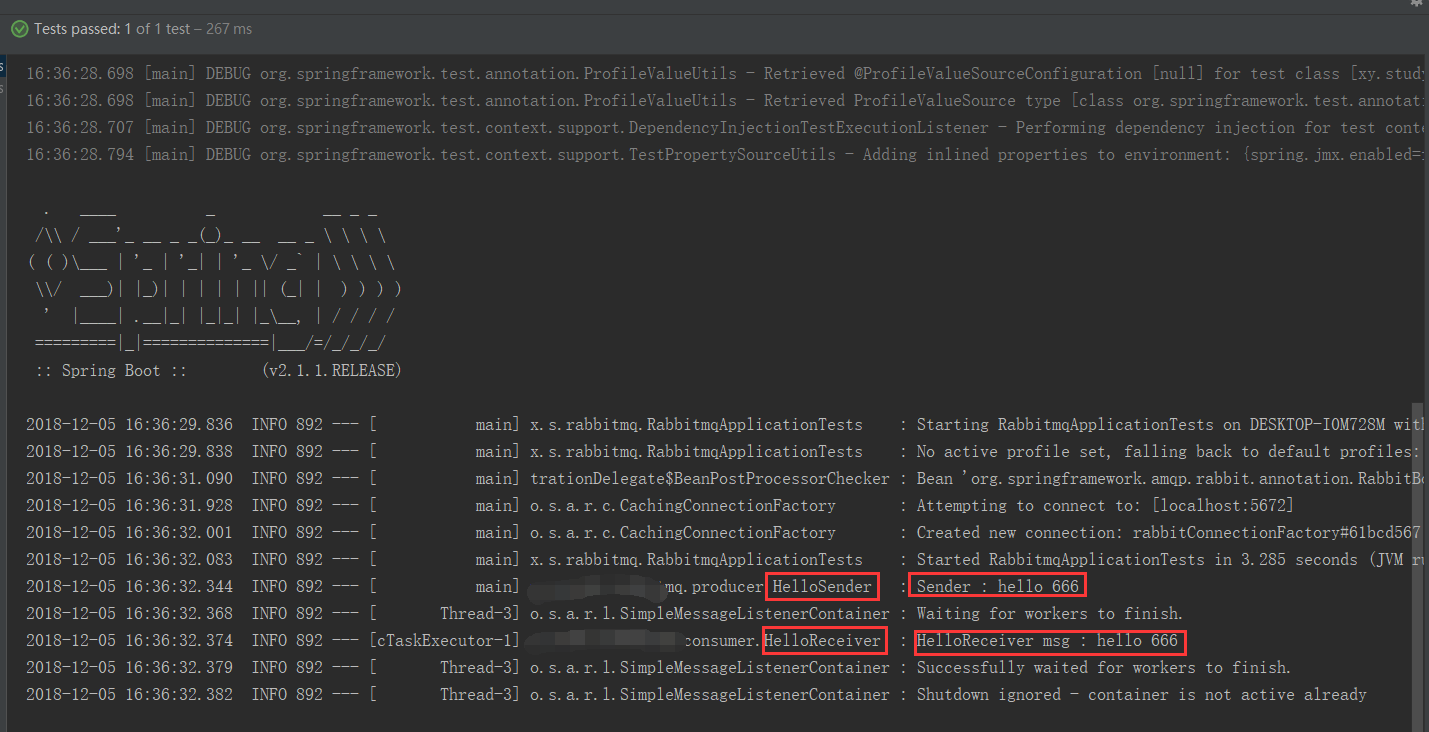SpringBoot整合RabbitMQ,实现消息发送和消费以及多个消费者的情况
配置文件application.properties:
1 2 3 4 5 6 7 8 | spring.application.name=spring-boot-rabbitmqspring.rabbitmq.host=localhostspring.rabbitmq.port=5672spring.rabbitmq.username=guestspring.rabbitmq.password=guestserver.port = 5678 |
RabbitMQ配置文件类(注释的代码可以直接删掉):
1 2 3 4 5 6 7 8 9 10 11 12 13 14 15 16 17 18 19 20 21 22 23 24 25 26 27 28 29 30 31 32 33 34 35 36 37 38 39 40 41 42 43 44 45 46 47 48 49 50 51 52 53 54 55 56 57 58 59 60 | import org.springframework.amqp.core.Binding;import org.springframework.amqp.core.BindingBuilder;import org.springframework.amqp.core.Queue;import org.springframework.amqp.core.TopicExchange;import org.springframework.context.annotation.Bean;import org.springframework.context.annotation.Configuration;/** * topic 是RabbitMQ中最灵活的一种方式,可以根据routing_key自由的绑定不同的队列 * 首先对topic规则配置 *///@Configurationpublic class TopicRabbitConfig { final public static String QUEUE_NAME = "queue.name"; final public static String TEST_TOPIC_ROUTINGKEY = "test.topic.routingKey"; final public static String TEST_EXCHANGE_HAHA = "test.exchange.haha"; /** * 设置交换器的名称 * @return *//* @Bean TopicExchange exchange() { return new TopicExchange(TopicRabbitConfig.TEST_EXCHANGE_HAHA); } *//** * 队列名称 * @return *//* @Bean public Queue queueMessage() { return new Queue(TopicRabbitConfig.QUEUE_NAME); } *//** * 将指定routing key的名称绑定交换器的队列 * @param queueMessage * @param exchange * @return *//* @Bean Binding bindingExchangeMessage(Queue queueMessage, TopicExchange exchange) { return BindingBuilder.bind(queueMessage).to(exchange).with(TopicRabbitConfig.TEST_TOPIC_ROUTINGKEY); }*/ /** * 匹配以topic开头的路由键routing key * 交换机绑定多个队列 */ /*@Bean Binding bindingExchangeMessages(Queue queueMessages, TopicExchange exchange) { return BindingBuilder.bind(queueMessages).to(exchange).with("topic.#"); }*/} |
生产者,这里根据Exchange和Routing Key,直接发送一个字符串:
1 2 3 4 5 6 7 8 9 10 11 12 13 14 15 16 17 18 19 20 21 22 23 24 25 | import lombok.extern.slf4j.Slf4j;import org.springframework.amqp.rabbit.core.RabbitTemplate;import org.springframework.beans.factory.annotation.Autowired;import org.springframework.stereotype.Component;import xy.study.rabbitmq.conf.TopicRabbitConfig;@Component@Slf4jpublic class HelloSender { @Autowired private RabbitTemplate rabbitTemplate; /** * 通过exchange和routingKey的方式 * rabbitTemplate.convertAndSend(String exchange, String routingKey, Object object) * @param i */ public void send(int i) { String context = "hello " + i; log.info("Sender : {}", context); this.rabbitTemplate.convertAndSend(TopicRabbitConfig.TEST_EXCHANGE_HAHA,TopicRabbitConfig.TEST_TOPIC_ROUTINGKEY, context); }} |
消费者,绑定对应的Exchange,Queue和Routing Key,直接打印获取的信息:
1 2 3 4 5 6 7 8 9 10 11 12 13 14 15 16 17 18 19 20 21 22 | import lombok.extern.slf4j.Slf4j;import org.springframework.amqp.core.ExchangeTypes;import org.springframework.amqp.rabbit.annotation.Exchange;import org.springframework.amqp.rabbit.annotation.Queue;import org.springframework.amqp.rabbit.annotation.QueueBinding;import org.springframework.amqp.rabbit.annotation.RabbitListener;import org.springframework.messaging.handler.annotation.Payload;import org.springframework.stereotype.Component;import xy.study.rabbitmq.conf.TopicRabbitConfig;@Component@Slf4jpublic class HelloReceiver { @RabbitListener(bindings = @QueueBinding( value = @Queue(value = TopicRabbitConfig.QUEUE_NAME, durable = "true"), exchange = @Exchange(value = TopicRabbitConfig.TEST_EXCHANGE_HAHA, type = ExchangeTypes.TOPIC), key = TopicRabbitConfig.TEST_TOPIC_ROUTINGKEY) ) public void onOrgDeleted(@Payload String msg) { log.info("HelloReceiver msg : {}",msg); }} |
测试类,调用生产者发送信息的函数send,消费者会监听消费:
1 2 3 4 5 6 7 8 9 10 11 12 13 14 15 16 17 18 19 20 | import org.junit.Test;import org.junit.runner.RunWith;import org.springframework.beans.factory.annotation.Autowired;import org.springframework.boot.test.context.SpringBootTest;import org.springframework.test.context.junit4.SpringRunner;import xy.study.rabbitmq.producer.HelloSender;@RunWith(SpringRunner.class)@SpringBootTestpublic class RabbitmqApplicationTests { @Autowired private HelloSender sender; @Test public void testSend() { sender.send(666); }} |
如图,控制台日志,能生成消息,并且能被对应的消费者消费。

topic exchange 通配路由中多个消费者的情况
修改消费者的代码如下:
1 2 3 4 5 6 7 8 9 10 11 12 13 14 15 16 17 18 19 20 21 22 23 24 25 26 27 28 29 30 31 32 33 34 35 36 37 38 39 40 41 42 43 44 45 46 47 48 49 50 51 52 53 54 55 56 57 58 59 60 61 62 63 | import lombok.extern.slf4j.Slf4j;import org.springframework.amqp.core.ExchangeTypes;import org.springframework.amqp.rabbit.annotation.Exchange;import org.springframework.amqp.rabbit.annotation.Queue;import org.springframework.amqp.rabbit.annotation.QueueBinding;import org.springframework.amqp.rabbit.annotation.RabbitListener;import org.springframework.messaging.handler.annotation.Payload;import org.springframework.stereotype.Component;import xy.study.rabbitmq.conf.TopicRabbitConfig;@Component@Slf4jpublic class HelloReceiver { /** * 下面四个消费者,exchange和RoutingKey都相同,最后两个消费者队列名都相同 * @param msg */ @RabbitListener(bindings = @QueueBinding( value = @Queue(value = TopicRabbitConfig.QUEUE_NAME, durable = "true"), exchange = @Exchange(value = TopicRabbitConfig.TEST_EXCHANGE_HAHA, type = ExchangeTypes.TOPIC), key = TopicRabbitConfig.TEST_TOPIC_ROUTINGKEY) ) public void queueName(@Payload String msg) { log.info("{}-----HelloReceiver msg : {}",TopicRabbitConfig.QUEUE_NAME,msg); } @RabbitListener(bindings = @QueueBinding( value = @Queue(value = TopicRabbitConfig.QUEUE_NAME+".test", durable = "true"), exchange = @Exchange(value = TopicRabbitConfig.TEST_EXCHANGE_HAHA, type = ExchangeTypes.TOPIC), key = TopicRabbitConfig.TEST_TOPIC_ROUTINGKEY) ) public void queueNameTest(@Payload String msg) { log.info("{}-----HelloReceiver msg : {}",TopicRabbitConfig.QUEUE_NAME+".test",msg); } /** * 这里我的消费者队列名"123445",是乱写的,也能够接受 * @param msg */ @RabbitListener(bindings = @QueueBinding( value = @Queue(value = 123445+"", durable = "true"), exchange = @Exchange(value = TopicRabbitConfig.TEST_EXCHANGE_HAHA, type = ExchangeTypes.TOPIC), key = TopicRabbitConfig.TEST_TOPIC_ROUTINGKEY) ) public void queueNameNumber(@Payload String msg) { log.info("{}-----HelloReceiver msg : {}",123445+""+".test",msg); } /** * 由于这个和上面的Exchange、RoutingKey、queue完全相同,所以这两个消费者,一条消息,只有一个能消费(随机) * @param msg */ @RabbitListener(bindings = @QueueBinding( value = @Queue(value = 123445+"", durable = "true"), exchange = @Exchange(value = TopicRabbitConfig.TEST_EXCHANGE_HAHA, type = ExchangeTypes.TOPIC), key = TopicRabbitConfig.TEST_TOPIC_ROUTINGKEY) ) public void queueNameNumberSame(@Payload String msg) { log.info("same+{}-----HelloReceiver msg : {}",123445+""+".test",msg); }} |
再次执行测试,测试结果如下:

总结:
上面四个消费者代码,Exchange和RoutingKey都相同,最后两个消费者队列名都相同。
根据结果可知,当Exchange和RoutingKey相同、queue不同时,所有消费者都能消费同样的信息;
当Exchange和RoutingKey、queue都相同时(最后两个消费者),消费者中只有一个能消费信息,其他消费者都不能消费该信息。





【推荐】国内首个AI IDE,深度理解中文开发场景,立即下载体验Trae
【推荐】编程新体验,更懂你的AI,立即体验豆包MarsCode编程助手
【推荐】抖音旗下AI助手豆包,你的智能百科全书,全免费不限次数
【推荐】轻量又高性能的 SSH 工具 IShell:AI 加持,快人一步
· 从 HTTP 原因短语缺失研究 HTTP/2 和 HTTP/3 的设计差异
· AI与.NET技术实操系列:向量存储与相似性搜索在 .NET 中的实现
· 基于Microsoft.Extensions.AI核心库实现RAG应用
· Linux系列:如何用heaptrack跟踪.NET程序的非托管内存泄露
· 开发者必知的日志记录最佳实践
· winform 绘制太阳,地球,月球 运作规律
· 超详细:普通电脑也行Windows部署deepseek R1训练数据并当服务器共享给他人
· TypeScript + Deepseek 打造卜卦网站:技术与玄学的结合
· AI 智能体引爆开源社区「GitHub 热点速览」
· 写一个简单的SQL生成工具